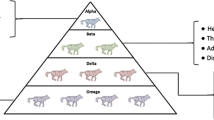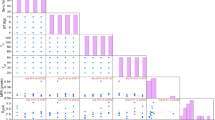Abstract
Optimization is a necessary task in process engineering to ensure maximization of the overall efficiency of production systems. Metaheuristic algorithms have gained enormous attention in the last decade to solve complex multi-modal optimization problems. Hybridization of metaheuristics is an interesting and fruitful research area as it improves performance capabilities of the existing algorithms. In this paper, a novel hybridized multi-objective optimization approach called TOPSIS-PR-GWO is introduced by combining a popular multi-criteria decision-making technique called TOPSIS (technique for order of preference by similarity to ideal solution) with grey wolf optimizer (GWO) for parametric optimization of an abrasive jet machining process. The polynomial regression (PR) metamodels are treated as the inputs to this hybrid optimizer. The performance of TOPSIS-PR-GWO is validated against the conventionally adopted weighted sum multi-objective optimization (WSMO) approach, and it is revealed that for the considered machining process, TOPSIS-PR-GWO provides 2 to 321% better solutions than those derived using WSMO approach. Moreover, TOPSIS-PR-GWO is also less computationally intensive than WSMO with approximately 3 to 9% savings in computational time.









Similar content being viewed by others
Data Availability
All data generated or analyzed during this study are included in this published article (and its supplementary information files).
Abbreviations
- AJM:
-
Abrasive jet machining
- ALO:
-
Ant lion optimization
- BA:
-
Bat algorithm
- BK:
-
Bottom kerf
- CoCoSo:
-
Combined compromise solution
- CRADIS:
-
Compromise ranking of alternatives from distance to ideal solution
- EEGWO:
-
Exploration-enhanced GWO
- GA:
-
Genetic algorithm
- GP:
-
Genetic programming
- GWO:
-
Grey wolf optimizer
- LGWO:
-
Lévy-embedded GWO
- MABAC:
-
Multi-attributive border approximation area comparison
- MARICA:
-
Multi-attributive real–ideal comparative analysis
- MCDM:
-
Multi-criteria decision-making
- MRR:
-
Material removal rate
- PR:
-
Polynomial regression
- PSO:
-
Particle swarm optimization
- SQP:
-
Sequential quadratic programming
- TK:
-
Top kerf
- TLBO:
-
Teaching–learning-based optimization
- TOPSIS:
-
Technique for order of preference by similarity to ideal solution
- VWGWO:
-
GWO with variable weights
- WOA:
-
Whale optimization algorithm
- WSMO:
-
Weighted sum multi-objective optimization
- \(\overrightarrow{a}\) :
-
A vector
- \(\overrightarrow{A}\) :
-
Coefficient vector
- A + :
-
Ideal solution in TOPSIS
- A − :
-
Anti-ideal solution in TOPSIS
- \(\overrightarrow{C}\) :
-
Coefficient vector
- CC i :
-
Closeness coefficient of ith alternative
- D :
-
Nozzle diameter
- L :
-
Stand-off distance
- m :
-
Number of alternatives
- n :
-
Number of criteria (responses)
- n ij :
-
Element of normalized decision matrix
- P :
-
Pressure
- \({\overrightarrow{r}}_{1}\) and \({\overrightarrow{r}}_{2}\) :
-
Random vectors
- r ij :
-
Element of weighted normalized decision matrix
- S :
-
Abrasive size
- S i + :
-
Distance from the ideal solution
- S i − :
-
Distance from the anti-deal solution
- t :
-
Iteration number
- t max :
-
Maximum iteration number
- \({\overrightarrow{W}}_{\left(t\right)}\) :
-
Position vector of grey wolf at iteration t
- \({\overrightarrow{W}}_{\left(t+1\right)}\) :
-
Position vector of grey wolf at iteration (t + 1)
- \({\overrightarrow{W}}_{p\left(t\right)}\) :
-
Position vector of prey at iteration t
- w j :
-
Weight of jth criterion
- X :
-
Fitness function value
- X max :
-
Maximum fitness function value
- X min :
-
Minimum fitness function value
- x ij :
-
Element of the initial decision matrix
- α, β, δ and ω :
-
Grey wolves
References
Abualigah L, Shehab M, Alshinwan M, Mirjalili S, Abd Elaziz M (2021) Ant lion optimizer: a comprehensive survey of its variants and applications. Arch Comput Meth Eng 28:1397–1416
Akay B, Karaboga D (2012) A modified artificial bee colony algorithm for real-parameter optimization. Inf Sci 192:120–142
Ashkzari A, Azizi (2014) Introducing genetic algorithm as an intelligent optimization technique. Appl Mech Mater 568–570:793–797
Azizi A (2017) Introducing a novel hybrid artificial intelligence algorithm to optimize network of industrial applications in modern manufacturing. Complexity Article ID 8728209:18
Azizi A (2020) Applications of artificial intelligence techniques to enhance sustainability of Industry 4.0: Design of an artificial neural network model as dynamic behavior optimizer of robotic arms. Complexity Article ID 8564140:10
Azizi A (2020) A case study on computer-based analysis of the stochastic stability of mechanical structures driven by white and colored noise: utilizing artificial intelligence techniques to design an effective active suspension system. Complexity Article ID 7179801:8
Azizi A (2019) Hybrid artificial intelligence optimization technique. In: Applications of Artificial Intelligence Techniques in Industry 4.0. Springer Nature Singapore 27–47
Bid S, Siddique G (2019) Human risk assessment of Panchet dam in India using TOPSIS and WASPAS multi-criteria decision-making (MCDM) methods. Heliyon 5:e01956
Brest J, Maučec MS (2008) Population size reduction for the differential evolution algorithm. Appl Intell 29:228–247
Chakraborty U (2008) Advances in differential evolution. The development and application of the differential evolution (DE). Springer, Berlin/heidelberg 143:319–333
Cheng T, Chen M, Fleming PJ, Yang Z, Gan S (2016) An effective PSO-TLBO algorithm for multi-objective optimization. In: Proc. of IEEE Congress on Evolutionary Computation, Vancouver 3977–3982
Deb K, Gupta H (2005) Searching for robust Pareto-optimal solutions in multi-objective optimization. In: Proc. of International Conference on Evolutionary Multi-criterion Optimization, Springer, Berlin 150–164
Gao W-F, Liu S-Y (2012) A modified artificial bee colony algorithm. Comput Oper Res 39:687–697
Gao Z-M, Zhao J (2019) An improved grey wolf optimization algorithm with variable weights. Computational Intelligence and Neuroscience Article ID 2981282:13. https://doi.org/10.1155/2019/2981282
Ghosh A, Das MK (2008) Non-dominated rank based sorting genetic algorithms. Fund Inform 83:231–252
Goel T, Vaidyanathan R, Haftka RT, Shyy W, Queipo NV, Tucker K (2007) Response surface approximation of Pareto optimal front in multi-objective optimization. Comput Methods Appl Mech Eng 196:879–893
Gul F, Rahiman W, Alhady SSN, Ali A, Mir I, Jalil A (2021) Meta-heuristic approach for solving multi-objective path planning for autonomous guided robot using PSO-GWO optimization algorithm with evolutionary programming. J Ambient Intell Humaniz Comput 12(7):7873–7890
Heidari AA, Pahlavani P (2017) An efficient modified grey wolf optimizer with Lévy flight for optimization tasks. Appl Soft Comput 60:115–134
Kalita K, Ragavendran U, Ramachandran M, Bhoi AK (2019) Weighted sum multi-objective optimization of skew composite laminates. Struct Eng Mech 69:21–31
Kaveh A, Zakian P (2018) Improved GWO algorithm for optimal design of truss structures. Engineering with Computers 34:685–707
Khan A, Maity KP (2016) Application of MCDM-based TOPSIS method for the optimization of multi quality characteristics of modern manufacturing processes. Int J Eng Res Afr 23:33–51
Kumar V, Kalita K, Madhu S, Ragavendran U, Gao X-Z (2021) A hybrid genetic programming-gray wolf optimizer approach for process optimization of biodiesel production. Processes 9(3):442. https://doi.org/10.3390/pr9030442
Lai Y-J, Liu T-Y, Hwang C-L (1994) TOPSIS for MODM. Eur J Oper Res 76:486–500
Liu B, Wang L, Jin Y-H (2007) An effective PSO-based memetic algorithm for flow shop scheduling. IEEE Transactions on Systems, Man, and Cybernetics. Part B (cybernetics) 37:18–27
Long W, Jiao J, Liang X, Tang M (2018) An exploration-enhanced grey wolf optimizer to solve high-dimensional numerical optimization. Eng Appl Artif Intell 68:63–80
Long W, Xu S (2016) A novel grey wolf optimizer for global optimization problems. In: Proc. of IEEE Advanced Information Management, Communicates, Electronic and Automation Control Conference, China 1266–1270
Madhu S, Balasubramanian M (2017) Effect of abrasive jet process parameters on machining glass fibre reinforced polymer composite. Materialwiss Werkstofftech 48:1146–1157
Marler RT, Arora JS (2010) The weighted sum method for multi-objective optimization: new insights. Struct Multidiscip Optim 41:853–862
Mirjalili S (2015) The ant lion optimizer. Adv Eng Softw 83:80–98
Mirjalili S, Mirjalili SM, Lewis A (2014) Grey wolf optimizer. Adv Eng Softw 69:46–61
Mirjalili S, Saremi S, Mirjalili SM, Coelho LDS (2016) Multi-objective grey wolf optimizer: a novel algorithm for multi-criterion optimization. Expert Syst Appl 47:106–119
Mirjalili S (2019) Genetic algorithm. In: Evolutionary Algorithms and Neural Networks, Springer 43–55
Mittal N, Singh U, Sohi BS (2016) Modified grey wolf optimizer for global engineering optimization. Applied Computational Intelligence and Soft Computing Article ID 7950348:16. https://doi.org/10.1155/2016/7950348
Mohammed H, Rashid T (2020) A novel hybrid GWO with WOA for global numerical optimization and solving pressure vessel design. Neural Comput Appl 32:14701–14718
Mousavi-Nasab SH, Sotoudeh-Anvari A (2017) A comprehensive MCDM-based approach using TOPSIS, COPRAS and DEA as an auxiliary tool for material selection problems. Mater Des 121:237–253
Mukherjee R, Chakraborty S, Samanta S (2012) Selection of wire electrical discharge machining process parameters using non-traditional optimization algorithms. Appl Soft Comput 12(8):2506–2516
Pardalos PM, Žilinskas A, Žilinskas J (2017) Non-convex multi-objective optimization. Springer 123
Premalatha K, Natarajan AM (2009) Hybrid PSO and GA for global maximization. International Journal of Open Problems in Computer Science and Mathematics 2:597–608
Savic D (2002) Single-objective vs. multiobjective optimisation for integrated decision support. Integrated Assessment and Decision Support 1:7–12
Shahbeig S, Helfroush MS, Rahideh A (2017) A fuzzy multi-objective hybrid TLBO-PSO approach to select the associated genes with breast cancer. Signal Process 131:58–65
Shivakoti I, Kibria G, Pradhan PM, Pradhan BB, Sharma A (2019) ANFIS based prediction and parametric analysis during turning operation of stainless steel 202. Mater Manuf Processes 34(1):112–121
Shivakoti I, Rodrigues LL, Cep R, Pradhan PM, Sharma A, Bhoi AK (2020) Experimental investigation and ANFIS-Based modelling during machining of EN31 alloy steel. Materials 13(14):3137
Stanimirovic IP, Zlatanovic ML, Petkovic MD (2011) On the linear weighted sum method for multi-objective optimization. Facta Universitatis Series: Mathematics and Informatics 26:49–63
Victoire TAA, Jeyakumar AE (2004) Hybrid PSO-SQP for economic dispatch with valve-point effect. Electric Power Systems Research 71:51–59
Vigneshwaran S, Uthayakumar M, Arumugaprabu V (2018) Abrasive water jet machining of fiber-reinforced composite materials. J Reinf Plast Compos 37:230–237
Wang P, Zhu Z, Wang Y (2016) A novel hybrid MCDM model combining the SAW, TOPSIS and GRA methods based on experimental design. Inf Sci 345:27–45
Yang X-S, Gandomi AH (2012) Bat algorithm: a novel approach for global engineering optimization. Eng Comput 29(5):464–483
Zhu H, Wang Y, Wang K, Chen Y (2011) Particle swarm optimization (PSO) for the constrained portfolio optimization problem. Expert Syst Appl 38:10161–10169
Author information
Authors and Affiliations
Corresponding author
Ethics declarations
Conflict of Interest
The authors declare no competing interests.
Additional information
Publisher's Note
Springer Nature remains neutral with regard to jurisdictional claims in published maps and institutional affiliations.
Appendix
Appendix
Rights and permissions
About this article
Cite this article
Kalita, K., Pal, S., Haldar, S. et al. A Hybrid TOPSIS-PR-GWO Approach for Multi-objective Process Parameter Optimization. Process Integr Optim Sustain 6, 1011–1026 (2022). https://doi.org/10.1007/s41660-022-00256-0
Received:
Revised:
Accepted:
Published:
Issue Date:
DOI: https://doi.org/10.1007/s41660-022-00256-0




